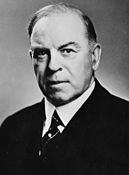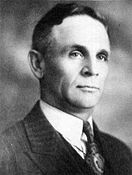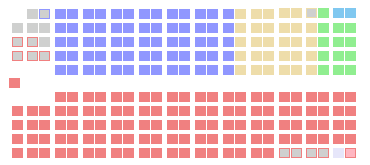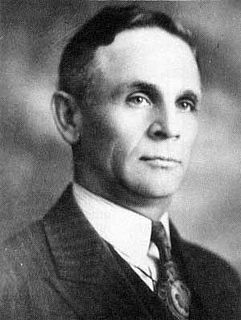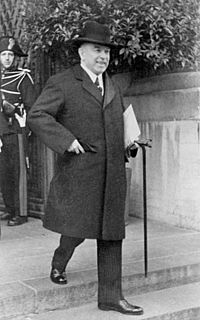| |||||||||||||||||||||||||||||||||||||||||||||||||||||||||||||||||||||||
245 seats in the 20th Canadian Parliament 123 seats needed for a majority | |||||||||||||||||||||||||||||||||||||||||||||||||||||||||||||||||||||||
|---|---|---|---|---|---|---|---|---|---|---|---|---|---|---|---|---|---|---|---|---|---|---|---|---|---|---|---|---|---|---|---|---|---|---|---|---|---|---|---|---|---|---|---|---|---|---|---|---|---|---|---|---|---|---|---|---|---|---|---|---|---|---|---|---|---|---|---|---|---|---|---|
| |||||||||||||||||||||||||||||||||||||||||||||||||||||||||||||||||||||||
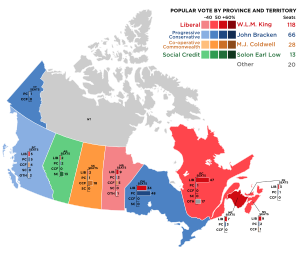 | |||||||||||||||||||||||||||||||||||||||||||||||||||||||||||||||||||||||
| |||||||||||||||||||||||||||||||||||||||||||||||||||||||||||||||||||||||
The Canadian federal election of 1945 was the 20th general election in Canadian history. It was held June 11, 1945 to elect members of the House of Commons of Canada of the 20th Parliament of Canada. Prime Minister William Lyon Mackenzie King's Liberal government was re-elected to its third consecutive government, although this time with a minority government as the Liberals fell five seats short of a majority.
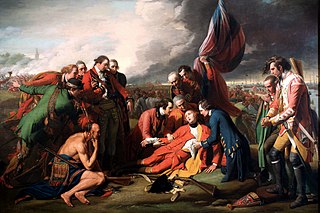
The history of Canada covers the period from the arrival of Paleo-Indians thousands of years ago to the present day. Prior to European colonization, the lands encompassing present-day Canada were inhabited for millennia by Indigenous peoples, with distinct trade networks, spiritual beliefs, and styles of social organization. Some of these older civilizations had long faded by the time of the first European arrivals and have been discovered through archaeological investigations.

The House of Commons of Canada is a component of the Parliament of Canada, along with the Sovereign and the Senate. The House of Commons currently meets in a temporary Commons chamber in the West Block of the parliament buildings on Parliament Hill in Ottawa, while the Centre Block, which houses the traditional Commons chamber, undergoes a ten-year renovation.
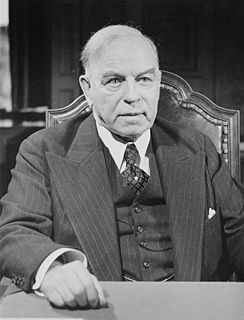
The 20th Canadian Parliament was in session from September 6, 1945, until April 30, 1949. The membership was set by the 1945 federal election on June 11, 1945, and it changed only somewhat due to resignations and by-elections until it was dissolved prior to the 1949 election.
Contents
Although the election officially resulted in a minority government, the election of eight "Independent Liberal" MPs, most of whom did not run as official Liberals because of their opposition to conscription (see Conscription Crisis of 1944), gave the King government an effective working majority in parliament. Most of the Independent Liberal MPs joined (or re-joined) the Liberal caucus following World War II when the conscription issue became moot. As King was defeated in his own riding of Prince Albert, fellow Liberal William MacDiarmid, who was re-elected in the safe seat of Glengarry, resigned so that a by-election could be held, which was subsequently won by King.
A minority government, or minority cabinet or minority parliament, is a cabinet formed in a parliamentary system when a political party or coalition of parties does not have a majority of overall seats in the parliament. It is sworn into office, with or without the formal support of other parties, to enable a government to be formed. Under such a government, legislation can only be passed with the support of enough other members of the legislature to provide a majority, encouraging multi-partisanship. In bicameral parliaments, the term relates to the situation in chamber whose confidence is considered most crucial to the continuance in office of the government.

Conscription, sometimes called the draft, is the compulsory enlistment of people in a national service, most often a military service. Conscription dates back to antiquity and continues in some countries to the present day under various names. The modern system of near-universal national conscription for young men dates to the French Revolution in the 1790s, where it became the basis of a very large and powerful military. Most European nations later copied the system in peacetime, so that men at a certain age would serve 1–8 years on active duty and then transfer to the reserve force.
The Conscription Crisis of 1944 was a political and military crisis following the introduction of forced military service for men in Canada during World War II. It was similar to the Conscription Crisis of 1917, but was not as politically damaging.
The federal election was the first since the victory of the Co-operative Commonwealth Federation in the Saskatchewan provincial election, and many predicted a major breakthrough for the CCF nationally. A Gallup poll from September 1943 showed the CCF with a one-point lead over both the Liberals and Conservatives. The party was expected to win 70 to 100 seats, possibly even enough to form a minority government. Despite the expectations, the party only won 28 seats.
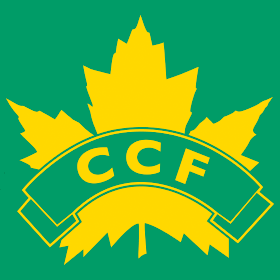
The Co-operative Commonwealth Federation (CCF) was a social-democratic and democratic socialist political party in Canada. The CCF was founded in 1932 in Calgary, Alberta, by a number of socialist, agrarian, co-operative, and labour groups, and the League for Social Reconstruction. In 1944, the CCF formed the first social-democratic government in North America when it was elected to form the provincial government in Saskatchewan. In 1961, the CCF was succeeded by the New Democratic Party (NDP). The full, but little used, name of the party was Co-operative Commonwealth Federation (Farmer-Labour-Socialist).
1945 was also the first test of the newly named Progressive Conservatives. The Conservative Party had changed its name in 1942 when former Progressive Party Premier of Manitoba John Bracken became its leader. The party improved its standing in terms of number of seats compared to the old Conservative Party, but also recorded a reduced share of the popular vote (indeed, the lowest in any election prior to 1993) and fell far short of challenging Liberal hegemony. Operation Downfall, the invasion of Japan, was scheduled for late 1945-early 1946. Bracken had promised conscription for the invasion of Japan whereas King had promised to commit one division of volunteers to the planned invasion of Japan. [1] Based on the way that the Japanese had fought the battles of Iwo Jima and Okinawa it was widely expected that the invasion of the Japanese home islands would be a bloody campaign, and Bracken's promise of conscription for the planned invasion of Japan did much to turn voters against his party. [2]

The Progressive Conservative Party of Canada (PC) was a federal political party in Canada.
The Progressive Party of Manitoba, Canada, was a political party that developed from the United Farmers of Manitoba (UFM), an agrarian movement that became politically active following World War I. A successor to the Manitoba Grain Growers' Association, the UFM represented the interests of farmers frustrated with traditional political parties.

The Premier of Manitoba is the first minister for the Canadian province of Manitoba. The premier is the province's head of government and de facto chief executive. In formal terms, the premier receives a commission to form a government from the Lieutenant Governor of Manitoba, who represents the monarch at the provincial level.
A key issue in this election seems to have been electing a stable government. The Liberals urged voters to "Return the Mackenzie King Government", and argued that only the Liberal Party had a "preponderance of members in all nine provinces". Mackenzie King threatened to call a new election if he was not given a majority: "We would have confusion to deal with at a time when the world will be in a very disturbed situation. The war in Europe is over, but unrest in the east is not over."
The Progressive Conservatives tried to capitalize on the massive mid-campaign victory by the Ontario Progressive Conservative Party in the 1945 Ontario provincial election. PC campaign ads exhorted voters to rally behind their party: "Ontario shows! Only Bracken can win!", and suggesting that it would be impossible to form a majority government in the country without a plurality of seats in Ontario, which only the Tories could win. In the event, the Liberals fell just short of a majority even though they won only 34 seats in Ontario to the PCs' 48 seats. Eight "Independent Liberal" MPs could be expected to support the government.
Social welfare programs were also an issue in the campaign. Another Liberal slogan encouraged voters to "Build a New Social Order" by endorsing the Liberal platform, which included
- $750 million to provide land, jobs and business support for veterans;
- $400 million of public spending to build housing;
- $250 million for family allowances;
- establishing an Industrial development Bank;
- loans to farmers, floor prices for agricultural products;
- tax reductions.
Campaigning under the slogan, "Work, Security, and Freedom for All -- with the CCF", the CCF promised to retain war-time taxes on high incomes and excess profits in order to fund social services, and to abolish the Senate of Canada. The CCF fought hard to prevent the support of labour from going to the Labor-Progressive Party (i.e., the Communist Party of Canada).

The Senate of Canada is the upper house of the Parliament of Canada, along with the House of Commons and the Monarch. The Senate is modelled after the British House of Lords and consists of 105 members appointed by the Governor General on the advice of the Prime Minister. Seats are assigned on a regional basis: four regions—defined as Ontario, Quebec, the Maritime provinces, and the Western provinces—each receive 24 seats, with the remaining portions of the country—Newfoundland and Labrador receiving 6 seats and the three northern territories each assigned the remaining one seat. Senators may serve until they reach the age of 75.
The Labor-Progressive Party was a legal political organization in Canada between 1943 and 1959.

The Communist Party of Canada is a communist political party in Canada founded in 1922. Although it is now a political party without any parliamentary representation, the party's candidates have been elected to the Parliament of Canada, the Ontario legislature, the Manitoba legislature, and various municipal governments across the country. The party has also contributed significantly to trade union organizing and labour history in Canada, peace and anti-war activism, and many other social movements.
The LPP, for its part, pointed out that the CCF's refusal to enter into an electoral pact with the LPP had cost the CCF 100,000 votes in the Ontario election, and had given victory to the Ontario PCs. It urged voters to "Make Labour a Partner in Government."
The Social Credit Party of Canada tried, with modest success, to capitalize on the positive image of the Alberta Socred government of William Aberhart, asking voters, "Good Government in Alberta -- Why Not at Ottawa?". Referring to social credit monetary theories, the party encouraged voters to "Vote for the National Dividend".
